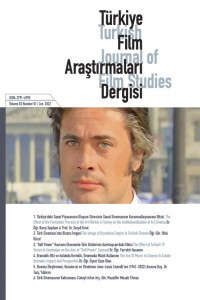Cléo’nun İzinden
Bu çalışma, Cléo from 5 to 7 (1962) filminin detaylı analizini yapmaktadır. Modern kadının bir temsilcisi haline gelmiş Cleo karakterinin izinde yapılacak tartışmalar aynı zamanda Agnes Varda’nın film yapma tekniklerini de tartışmaya açacaktır. Filmi şehir ve kadın temsili üzerinden tartışılacak olan bu araştırma, analizini feminist bir çerçevede ele almaktadır. Böylece, alışılagelen kadın figürü temsillerinin, Varda tarafından nasıl bertaraf edildiği ve şehirle kurulan bir etkileşimin kadını (ve şehri) karşılıklı olarak nasıl dönüştürdüğü önerilecektir.
Anahtar Kelimeler:
Agnès Varda, Cléo from 5 to 7, 5’ten 7’ye Cléo, feminist filmler, kadın yönetmenler, şehir çalışmaları
Following in the Footsteps of Cléo
This study aims to analyse the film Cléo from 5 to 7 (1962) by following in the footsteps of Cléo who is a great representative of modern woman. In the embodiment of Cléo, some threads that are attributed to the women will be brought into the discussion, together with the artistic techniques subtly applied by the director Agnes Varda. This study whose aim is to discuss the film within the woman and city representation takes its basis from the feminist framework. Thus, how the long lasting women representations are subverted through the woman and city interaction, which bears a hope for transformation will be suggested.
Keywords:
Agnès Varda, Cléo from 5 to 7, feminist films, woman directors urban studies, : Agnès Varda, 5’ten 7’ye Cléo, feminist filmler, kadın yönetmenler, şehir çalışmaları,
___
- Baudelaire, C. (1964). The Painter of Modern Life and Other Essays. Phaidon Press.
- Benjamin, W. (1997). Charles Baudelaire: A Lyric Poet in the Era of High Capi-talism, trans. Harry Zohn. Verso
- Bénézet, D. (2014). The cinema of Agnès Varda: Resistance and eclecticism. Columbia University Press. Elkin, L. (2017). Flâneuse: Women Walk the City in Paris, New York, Tokyo, Ven-ice and London. First American ed., Farrar, Straus and Giroux. Kindle Edition.
- Engeln, R. (2017). Beauty sick: How the cultural obsession with appearance hurts girls and women. Harper-Collins. https://www.youtube.com/watch?v=63XsokRPVY
- Flitterman-Lewis, S. (1990). To Desire Differently: Feminism and the French Cinema. University of Illinois Press.
- Gorbman, C. (1981). Cléo from 5 to 7: Music as Mirror. Wide Angle, 4:4, pp.38–49.
- Haskell, M. (2000). Cléo from 5 to 7. The Criterion Collection. http://www.crite-rion.com/current/posts/87-cleo-from-5-to-7.
- Mandy, M. (2000). Filmer le desir. the factory/Saga Film/ARTE France/
- Martin, A. (2008). Cléo from 5 to 7: Passionate Time. Criterion. Available at: https://www.criterion.com/current/posts/499-cl-o-from-5-to-7-passionate-time (last visited on 20 June 2021).
- Mouton, J. (2001). From feminine masquerade to flâneuse: Agnès Varda's Cléo in the city. Cinema Journal, 40(2), 3-16. from http://www.jstor.org/sta-ble/1225840
- Mulvey, L., (1989). “Visual pleasure and narrative cinema” Visual and other pleasures. Palgrave Macmillan. (first published in 1975)
- Özgen-Tuncer, A. (2012). Women on the move: The politics of walking in Agnès Varda. Edinburgh University Press, 103–116. DOI: 10.3366/dls.2012.0049
- Varda, A. (2018). Inspiration and good mood: THAT’S CINEMA! | Agnès Varda | TEDxVeniceBeach. YouTube. Available at: https://www.youtube.com/watch?v=HmGap7-RxdA&t=11s
- Başlangıç: 2021
- Yayıncı: Film Araştırmaları Derneği
Sayıdaki Diğer Makaleler
Wong Kar Wai Filmlerinde Sesin Anlatıya Etkisi: Hong Kong Ekspresi ve Düşkün Melekler Örneği,
Sinemanın Denetimsiz Teknolojiyle Sınavı: Yapay Zeka’nın Film Endüstrisine Etkisi
Madam Curie değil Maria kürü üzerine bir film
Çağdaş Sinemaya Kültürel Çalışmalar Literatüründen Bir Bakış
Ne Dost Ne De Yabancı: Gişe Memuru Filminde “Meçhul Dost”u Düşünmek
Scopus Veri Tabanında Yer Alan Üçüncü Sinema Konulu Akademik Çalışmaların Bibliyometrik Analizi
Gökhan BAK, Alparslan BAK, Yunus Emre ÖZDEMİR, Nurettin ATAŞ
